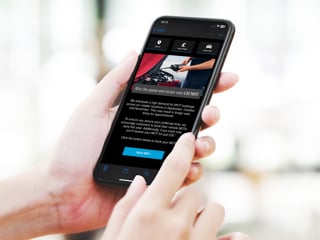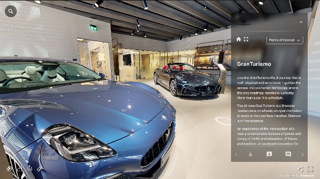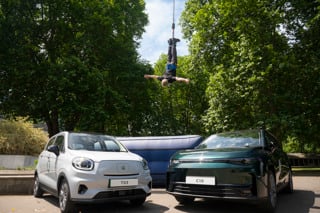In an era of video-on-demand, Netflix and YouTube, dealers can take advantage of 24/7 screen access to reach their customers. We source some best-practice tips from industry leaders.
1: What to use video for
With the penetration of smartphones in modern society, almost every car buyer and owner has a video player in their pocket – which is an important means of contact for dealers.
Dene Jones, the chief marketing and data officer at BCA, told us: “Video is used to support sales along the customer journey. App-based solutions enable dealers to capture a perfect video walkaround of every vehicle, complete with professional and consistent images. Once the video is captured, it can be instantly uploaded to a wide range of channels, from websites to social media platforms, classified sites and direct channels, such as text or email.”
Luke Phillips, the head of marketing at web agency Gforces, added: “With up to 95% of the messaging within a video likely to be retained by the person viewing it, video is one of the most effective marketing tools a dealer can have in their repertoire, and the huge potential it offers is only just beginning to be explored.”
Marshall Motor Group has seen that potential and is already using video. Philip J Deacon, Marshall’s head of marketing, said: “We use video and rich media across our sales and service operations, and actively across our other digital assets and social communities. This is used to enhance the experience, and video is a great way to reach potential customers and maintain relationships with them.”
2: Tailoring video for your website and interactions with customers
Alistair Horsburgh, the chief executive of CitNow, explained how dealers can use video at different stages of the buying journey.
“At the beginning of the sales process, the web solution allows dealers to capture their digital assets on a single device. We store them on behalf of the dealer and make them available to all of the classified sites, and the
individual dealer’s own website. We help the dealer to make their stock more interesting for consumers when they’re surfing the internet.
“Also, when a customer makes an inquiry to a dealership, say for a used vehicle, our sales application allows a sales exec to go outside and, utilising our
application on an Apple or an Android device, introduce himself to the customer and show them the vehicle that they made the inquiry about. They then send a secure link to the customer, who can watch it at their leisure. That personalisation really makes a difference to dealerships.”
Phillips added: “The great thing about video is that it usually has a built-in call to action. It’s created to evoke a specific response or desired reaction in the viewer. Reaction in some form is practically guaranteed. Very few marketing platforms offer that.”
3: Video and social media
Social media often gets a bad rap, but many dealers have identified its commercial potential as a way of reaching out to consumers and promoting a range of messages.
Cambria Automobiles uses social media extensively, said its marketing director, Ian Godbold.
“We do a number of things, such as ‘car of the week’ or ‘car of the day’, or introduction videos. We’ll also promote our activities and offers through Facebook, Instagram, Twitter. Google Places also has a facility to have offers and promotions using the Google Offer Card, and we have been utilising those videos. We’re seeing huge engagement coming through those channels.”
Deacon said Marshall uses lots of video – which increases its post-engagement.
It uses a combination of manufacturer footage, plus professional video and in-house videos to promote its products and services.
“Our objective with social media is not to directly sell products or services: it’s to showcase our company, our people, our products and services, our credibility and likeability (our #marshallmoments). On Facebook last year, we reached 60.3 million people and engaged with 1.1m. On Twitter, we had 10.5m impressions and were mentioned 11,500 times.”
4: The role of video for servicing and health check customers
Video is now well established as a means of communicating what work is required when a customer’s car is in for service or repair.
Horsburgh said: “It’s a visual aid to give the technician an ability to communicate with a customer what’s wrong with their vehicle.”
Godbold added: “With service, you’re actually showing what’s wrong with the car and what needs to be done, giving customers the opportunity to sign that off. We do that through email and text after they watch the video. That’s where we see a big conversion coming through that channel.”
Deacon said: “With a video, you can actually show the customer their vehicle, identify an issue and get an
immediate answer, rather than having to wait for that. It offers so much more trust and transparency.”
5: Other uses of video – now and in the future
Apart from sales and servicing functions, dealers are finding many other ways to use video. Deacon said Marshall uses it for a variety of functions, including pre-delivery videos sent to customers on the scheduled day of
collection, to heighten the sense of occasion; handover reveals for posting on social media; new-plate promotional events; how-to guides; tie-ups with social media influencers; even time-lapse videos of new showroom builds.
Godbold said Cambria uses Google 360 tours, virtual and 3D tours of showrooms.
“What we’re seeing now is that consumers want to engage through video chat. There’s so much more information they can get utilising Google and looking at a video, rather than just looking at 80 or 90 pictures. They can get so much more from the actual video itself, particularly from a personalised video,” he said.
CitNow is also looking to the future, with additional functionality. Horsburgh said there are other areas that it is looking to expand, most of them with manufacturer programmes. “For example, we’re looking to put video into the warranty reclaim process when vehicles go back into dealerships to have warranty work done.
“Also, anything that we can do that will enhance customer satisfaction. Customer service is very high up our agenda, so anything that we can do, from a dealer’s perspective and from a communication point of view, is valuable. Two-way messaging, for example – trying to give the customer the ability to text back if they want to. It’s all about simplifying the communication process between the consumer and dealer.”
6: Measuring success
Dealers need to be able to see that the investment in video is providing a return.
Deacon monitors the efficacy of video in a number of ways: “We look at open rates of emails/videos, click-through rates, how many minutes have been watched, how many engagements and views, the stickiness and time spent on our website, and how many followers we have and how many likes are generated. There are lots of different measures of success and KPIs.”
The immediacy of a reaction to video is another useful way of measuring success. Phillips said: “Video really does allow you to respond to ‘in-the-moment’ opportunities and, as response is usually instant, whether or not it’s working is usually easy to pick up on. Combined with trackable telephone numbers or embedded links, seeing if your content is successfully reaching an audience and being responded to is no more difficult than with any other content.”
Godbold said: “As soon as a guest has viewed that video, we get a notification to say, ‘The consumer has just watched this’. This is a great time to pick up the phone and speak to them, because we know that they’ve watched it.”



















Login to comment
Comments
No comments have been made yet.